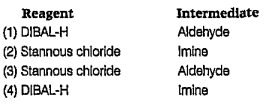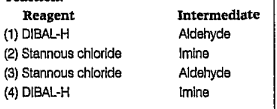Select the reagent used and the intermediate formed in stephen reaction




The correct Answer is:B
Step-by-Step Solution:
1. Understanding the Stephen Reaction: The Stephen reaction is a method used to convert nitriles (R-CN) into aldehydes (R-CHO) using stannous chloride (SnCl2) in the presence of hydrochloric acid (HCl) and water (H2O).
2. Identifying the Reagent: The main reagent used in the Stephen reaction is stannous chloride (SnCl2). This reagent acts as a reducing agent in the reaction.
3. Reaction Conditions: The reaction is typically carried out in an acidic medium, which is provided by hydrochloric acid (HCl). Water (H2O) is also present in the reaction mixture to facilitate the conversion.
4. Formation of the Intermediate: The intermediate formed during the Stephen reaction is an imine (R-CH=NH). This intermediate is formed when the nitrile (R-CN) is reduced to an imine before being hydrolyzed to yield the final aldehyde product.
5. Final Product: The final product of the Stephen reaction is an aldehyde (R-CHO), which is obtained after hydrolysis of the imine intermediate.
Summary:
- Reagent Used: Stannous Chloride (SnCl2), HCl, and H2O
- Intermediate Formed: Imine (R-CH=NH)
---
- Reagent Used: Stannous Chloride (SnCl2), HCl, and H2O
- Intermediate Formed: Imine (R-CH=NH)
Similar Questions
Knowledge Check
- Question 1 - Select One
Intermediate formed during E2 reaction is -
ACarbocationBCarbanionCFree radicalDIntermediate is not Formed - Question 2 - Select One
Intermediate formed during E1 reaction is -
ACarbocationBCarbanionCFree radicalDCarbene - Question 3 - Select One
Select the reagent used in the rosenmund reaction.
AH2BPd−baSO4Cboth (1) and both 2Dnone of these
What is the reagent used in Stephen reaction ?
View SolutionThe structure of the intermediate formed in the Riemer Tiemann reaction is :
View SolutionName the reagent used in this reaction.
 View Solution
View SolutionToluene on reaction with CrO3 and Ac2O gives benzaldehyde as the main product. The intermediate compound formed in the reaction is:
View SolutionWhich of the following is an intermediate formed in the reaction shown below
CH3−O∣∣C−CI+NH3→ Intermediate → product.View Solution

